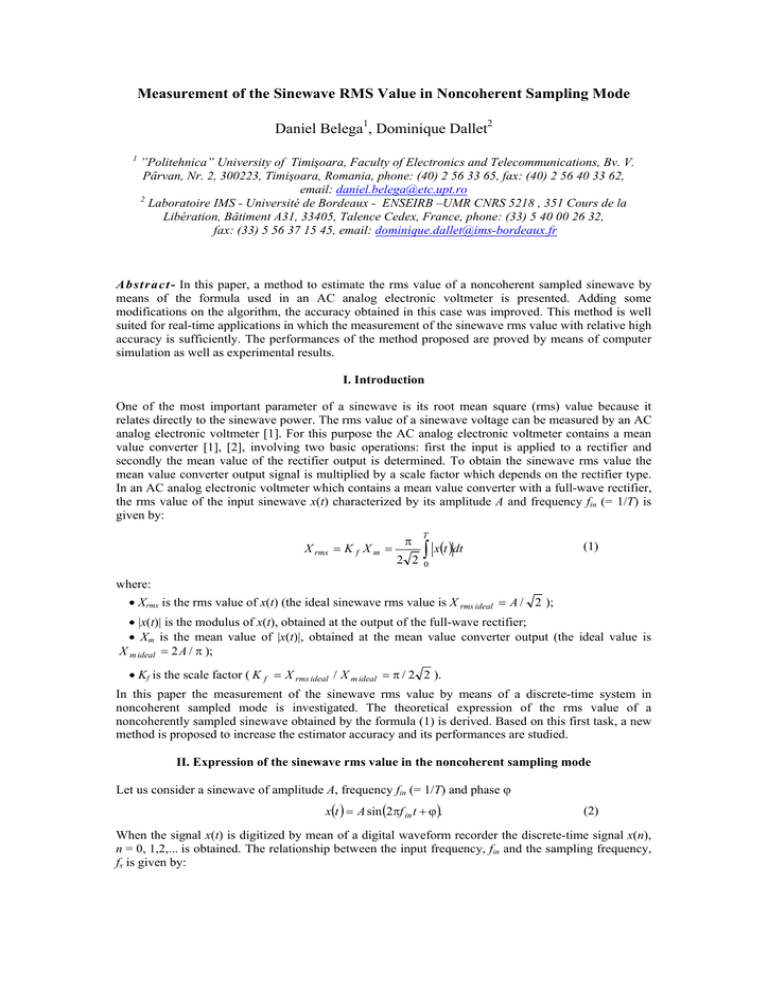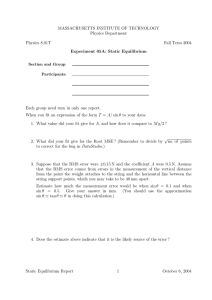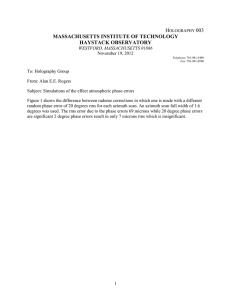Measurement of the Sinewave RMS Value in Noncoherent
advertisement

Measurement of the Sinewave RMS Value in Noncoherent Sampling Mode Daniel Belega1, Dominique Dallet2 1 ”Politehnica” University of Timişoara, Faculty of Electronics and Telecommunications, Bv. V. Pârvan, Nr. 2, 300223, Timişoara, Romania, phone: (40) 2 56 33 65, fax: (40) 2 56 40 33 62, email: daniel.belega@etc.upt.ro 2 Laboratoire IMS - Université de Bordeaux - ENSEIRB –UMR CNRS 5218 , 351 Cours de la Libération, Bâtiment A31, 33405, Talence Cedex, France, phone: (33) 5 40 00 26 32, fax: (33) 5 56 37 15 45, email: dominique.dallet@ims-bordeaux.fr Abstract- In this paper, a method to estimate the rms value of a noncoherent sampled sinewave by means of the formula used in an AC analog electronic voltmeter is presented. Adding some modifications on the algorithm, the accuracy obtained in this case was improved. This method is well suited for real-time applications in which the measurement of the sinewave rms value with relative high accuracy is sufficiently. The performances of the method proposed are proved by means of computer simulation as well as experimental results. I. Introduction One of the most important parameter of a sinewave is its root mean square (rms) value because it relates directly to the sinewave power. The rms value of a sinewave voltage can be measured by an AC analog electronic voltmeter [1]. For this purpose the AC analog electronic voltmeter contains a mean value converter [1], [2], involving two basic operations: first the input is applied to a rectifier and secondly the mean value of the rectifier output is determined. To obtain the sinewave rms value the mean value converter output signal is multiplied by a scale factor which depends on the rectifier type. In an AC analog electronic voltmeter which contains a mean value converter with a full-wave rectifier, the rms value of the input sinewave x(t) characterized by its amplitude A and frequency fin (= 1/T) is given by: X rms = K f X m = π 2 2 T ∫ x(t )dt (1) 0 where: • Xrms is the rms value of x(t) (the ideal sinewave rms value is X rms ideal = A / 2 ); • |x(t)| is the modulus of x(t), obtained at the output of the full-wave rectifier; • Xm is the mean value of |x(t)|, obtained at the mean value converter output (the ideal value is X m ideal = 2A / π ); • Kf is the scale factor ( K f = X rms ideal / X m ideal = π / 2 2 ). In this paper the measurement of the sinewave rms value by means of a discrete-time system in noncoherent sampled mode is investigated. The theoretical expression of the rms value of a noncoherently sampled sinewave obtained by the formula (1) is derived. Based on this first task, a new method is proposed to increase the estimator accuracy and its performances are studied. II. Expression of the sinewave rms value in the noncoherent sampling mode Let us consider a sinewave of amplitude A, frequency fin (= 1/T) and phase ϕ x(t ) = A sin (2πf in t + ϕ). (2) When the signal x(t) is digitized by mean of a digital waveform recorder the discrete-time signal x(n), n = 0, 1,2,... is obtained. The relationship between the input frequency, fin and the sampling frequency, fs is given by: f in J + δ = fs N (3) where N is the number of recorded samples, J is the number of complete recorder cycles and δ is the fractional part of the recorded cycles (0 ≤ δ < 1). For δ = 0 the sampling process is considered as coherent in terms of frequencies [3]. The theoretical rms value of x(t) considering the recording interval is: X rms = K f 1 (J + δ)T ( J + δ )T ∫ A sin(2πf in t + ϕ) dt (4) 0 in which K f = π / 2 2 . So, the rms value of x(n) can be estimated by: 1 Xˆ rms = K f N N −1 ⎛ ∑ A sin⎜⎝ 2π n =0 J +δ ⎞ n + ϕ⎟ N ⎠ (5) and the relationship between Xrms and X̂ rms is X rms = lim Xˆ rms . N →∞ (6) Xrms is given by (see Appendix) X rms ~ )⎤ ⎧ ⎡ J sin (πδ) sin (πδ + ϕ + ⎪ X rms ideal ⎢ ⎥, 2(J + δ ) ⎣J +δ ⎦ ⎪ ~ )⎤ ⎡ J 1 + cos(πδ) cos(πδ + ϕ ⎪ = ⎨ X rms ideal ⎢ + ⎥, 2(J + δ ) ⎣J +δ ⎦ ⎪ ~ )⎤ ⎡ J 2 + sin (πδ) sin (πδ + ϕ ⎪ ⎥, ⎪ X rms ideal ⎢ J + δ + 2(J + δ ) ⎣ ⎦ ⎩ if ~ / (2π) 0 ≤ δ < 0.5 − ϕ if ~ / (2π) ≤ δ < 1 − ϕ ~ / (2π) 0.5 − ϕ if ~ / (2π) ≤ δ < 1 1− ϕ (7) if 0 ≤ ϕ < π ~ = ⎧ϕ, in which ϕ ⎨ϕ − π, if π ≤ ϕ < 2π . From the above expression it can be established that if δ = 0 or ⎩ 0.5, then Xrms = Xrms ideal. Fig. 1 shows Xrms (calculated by (7)) and X̂ rms (calculated by (5)) as a function of the number of recorded cycles (i.e. J + δ). The sinewave obtained by simulation is characterized by its amplitude A = 2 and its phase ϕ = 2π/3 rad. The number of recorded cycles varies in the range [40, 45] with an increment of 0.1. The number of recorded samples is N = 2048. Fig. 1. Xrms (solid line) and X̂ rms (dotted line) as a function of the number of recorded cycles. As it was observed in Fig. 1 the differences between Xrms and X̂ rms are relatively small. In order to be more precise, using (7) the relative error of the rms value measurement was established as: ε rms ~) ⎧ sin (πδ) sin (πδ + ϕ δ , − + ⎪ 2(J + δ ) ⎪ J +δ ~) ⎪ 1 + cos(πδ) cos(πδ + ϕ δ = ⎨− + , 2(J + δ ) ⎪ J +δ ~) ⎪ 2 + sin (πδ) sin (πδ + ϕ δ + , ⎪− 2(J + δ ) ⎩ J +δ if ~ / (2π) 0 ≤ δ < 0.5 − ϕ if ~ / (2π ) ≤ δ < 1 − ϕ ~ / (2π) 0.5 − ϕ if ~ / (2π) ≤ δ < 1 1− ϕ (8) From the above expression it has been demonstrated that the maximum relative error εrms,was given by: ε rms max ⎧ ⎧ sin (πδ) 1 − cos(πδ) ⎫ δ δ + + ,− ⎬, ⎪max ⎨− 2(J + δ ) ⎭ ⎪ ⎩ J + δ 2(J + δ ) J + δ =⎨ ⎪max ⎧− δ + 1 − cos(πδ) ,− δ + 2 − sin (πδ) ⎫, ⎬ ⎨ ⎪ J +δ 2(J + δ ) 2(J + δ ) ⎭ ⎩ J +δ ⎩ 0 ≤ δ < 0.5 if (9) if 0.5 ≤ δ < 1 Fig. 2 shows the maximum of the relative error modulus of ε rms in % as function of the number of recorded cycles obtained during ϕ scan (ϕ varies in the range [0, 2π) rad. with an increment of π/50 rad). The number of recorded cycles varies in the range [40, 45] with an increment of 0.1. The sinewave signal is the one used to obtain the results presented in Fig. 1. Fig. 2. The maximum of the relative error modulus of the rms value measurement as function of the number of recorded cycles obtained during ϕ scan in the range [0, 2π) rad. As it can be observed from Fig. 2 for J ≥ 40 the maximum of the relative error modulus is smaller than 0.26%. III. A new method to improve the rms value estimation It is obvious that the bias of the rms value measurement is determined by the part of signal period δT at the end of (J + δ)T. A method to reduce the bias of the rms value measurement is to multiply a priori the signal x(t) by a window w(t). Thus, the signal xw(t) = x(t)⋅ w(t) is obtained. Ones of the most used windows are the cosine windows [4], defined by : w(t ) = H −1 ⎛ 2πht ⎞ ∑ a h cos⎜⎜⎝ (J + δ)T ⎟⎟⎠ (10) h =0 where H is the window order and ah are the window coefficients. The theoretical rms value of xw(t) during the recording interval is: X w rms = K f 1 (J + δ)T ( J + δ )T ∫ A sin(2πf in t + ϕ) w(t ) dt. 0 In case of coherent sampling, after some calculus, it can be established that (11) X w rms = a 0 X rms ideal . (12) Based on the above expression the rms value of x(n) can be estimated by: 1 1 ~ X rms = Kf a0 N N −1 1 ˆ X w rms ∑ x(n)w(n) = a 0 (13) n =0 where w(n) is the discrete-time H-term cosine window. It should be noted that for a discrete-time Hterm cosine window, a0 is equal to the normalized window peak signal gain NPSG ( NPSG = N −1 ∑ w(n) / N ). n =0 Fig. 3 shows the maximum of relative errors modulus of the rms value measurement obtained using (5) ~ for X̂ rms and (13) for X rms as function of the recorded cycles number during ϕ scan. When the rms ~ value is estimated by X rms , the Hann window and 4-term Blackman Harris window were used. The amplitude of sinewave was A = 2. The phase of the sinewave ϕ varies in the range [0, 2π) rad. with an increment of π/50 rad. The number of cycles recorded varies in the range [40, 45] with an increment of 0.1. The number of the recorded samples is N = 2048. The same sinewave as in Fig. 1 is used. (a) (b) Fig. 3. The maximum of the relative errors modulus of the rms value as function of the recorded cycles number obtained during ϕ scan in the range [0, 2π)rad. The rms value is estimated by: ~ a) X̂ rms (‘x’ mark and dotted line) and b) X rms with Hann window (star and dotted line) and 4-term Blackman-Harris (circle and dotted line). ~ From Fig. 3 it is clearly evident that the rms value is more accurately estimated by X rms than X̂ rms . ~ When the rms value is estimated by X rms the maximum of the relative error modulus is smaller than 0.06% (more than four times smaller than when the rms value is estimated by X̂ rms ). IV. Experimental results The performances of the method proposed are also verified by means of experimental results. For this purpose several acquisitions are made at different sinewave frequencies between 1878 – 1920 Hz. The amplitudes of the sinewaves are equal to 2 V. The sinewaves are obtained from the HM8130 signal generator. The TMS320C5x board is used as the acquisition system. The sampling frequency is 48077 Hz. For each frequency a number of 25 records are collected. Each record contains N =1024 samples. The sinewave rms value is estimated also by means of the Interpolated Discrete Fourier Transform (IpDFT) method with Hann window [5]. The IpDFT method provides very high accurate estimate of the amplitude of a sinewave (and also of the sinewave rms value). Fig. 4 shows the modulus of the difference between the average of the sinewave rms values estimated by the proposed method and the one of the rms values estimated by means of the IpDFT method as a function of frequency. In the proposed method the Hann window and 4-term Blackman-Harris window are employed. Fig. 4. The modulus of the difference between the average of the sinewave rms values estimated by the proposed method and the one of the rms values estimated by means of the IpDFT method as a function of frequency. In the proposed method the Hann window (star and dotted line) and the 4-term Blackman-Harris window (circle and dotted line) are used. The results obtained by the proposed method differ from the ones obtained by means of the IpDFT method beginning to the fourth digit after the decimal point. Thus, the sinewave rms values are high accurately estimated by the proposed method. V. Conclusion The expression of the rms value of noncoherently sampled sinewave calculated by the formula based on an AC analog voltmeter works is derived. To increases the rms value estimation accuracy obtained by using the derived expression a method is proposed. By appropriate choice of J and N values the rms value can be relative high accurately estimated by the proposed method. The performances of this method have been proven by computer simulation and also by experimental results. The main advantage of the proposed method is that this is very simple to implement. Thus, the proposed method is well suited for real-time measurement of the rms value of a discrete-time sinewave. Appendix Calculation of Xrms The rms value of the part of the sinewave x(t) (given by (2)) that was discretized is X rms = K f δT + ∫ 0 1 (J + δ)T ( J + δ )T ∫ A sin (2πf in t + ϕ) dt = K f 0 ⎡ JT 1 ⎢ A sin (2πf in t + ϕ) dt (J + δ)T ⎣⎢ ∫0 ⎤ J 1 A sin (2πf in t + ϕ) dt ⎥ = X rms ideal +Kf ( J +δ J + δ )T ⎥⎦ δT (A.1) ∫ A sin(2πf in t + ϕ) dt. 0 For 0 ≤ ϕ < π • if 0 ≤ δT < t1, where t1 = (π-ϕ)T/(2π), it can be established δT ∫ 0 Thus, Xrms becomes A sin (2πf in t + ϕ) dt = δT ∫ A sin (2πf in t + ϕ)dt = 0 AT sin (πδ) sin (πδ + ϕ). π (A.2) ⎡ J sin (πδ) sin (πδ + ϕ) ⎤ X rms = X rms ideal ⎢ + ⎥. 2(J + δ ) ⎣J +δ ⎦ (A.3) • if t1 ≤ δT < t2, where t2 = (2π-ϕ)T/(2π), it can be established δT ∫ 0 t1 δT 0 t1 A sin (2πf in t + ϕ) dt = ∫ A sin (2πf in t + ϕ)dt − ∫ A sin (2πf in t + ϕ)dt = AT AT + cos(πδ) cos(πδ + ϕ). π π (A.4) Thus, Xrms becomes ⎡ J 1 + cos(πδ) cos(πδ + ϕ) ⎤ X rms = X rms ideal ⎢ + ⎥. 2(J + δ ) ⎣J +δ ⎦ (A.5) • if t2 ≤ δT < T, it can be established δT ∫ 0 t1 t2 δT 0 t1 t2 A sin (2πf in t + ϕ) dt = ∫ A sin (2πf in t + ϕ)dt − ∫ A sin (2πf in t + ϕ)dt + ∫ A sin (2πf in t + ϕ)dt (A.6) 2 AT AT = + sin (πδ) sin (πδ + ϕ). π π Thus, Xrms becomes ⎡ J 2 + sin (πδ) sin (πδ + ϕ) ⎤ + X rms = X rms ideal ⎢ ⎥. 2(J + δ ) ⎣J +δ ⎦ (A.7) For π ≤ϕ < 2π, the same procedure is used and the same expression for Xrms is obtained, but with ϕ replaced by ϕ-π. Thus, expression of Xrms is given by X rms ~ )⎤ ⎧ ⎡ J sin (πδ) sin (πδ + ϕ X + ⎪ rms ideal ⎢ ⎥, 2(J + δ ) ⎣J +δ ⎦ ⎪ ⎪ ~ )⎤ ⎡ ( ) ( + πδ πδ + ϕ 1 cos cos J ⎪ = ⎨ X rms ideal ⎢ + ⎥, 2(J + δ ) ⎣J +δ ⎦ ⎪ ⎪ ~ )⎤ ⎡ J ( ) ( 2 sin sin + πδ πδ + ϕ ⎪ X rms ideal ⎢ + ⎥, 2(J + δ ) ⎪⎩ ⎣J +δ ⎦ if ~ / (2π) 0 ≤ δ < 0.5 − ϕ if ~ / (2π) ≤ δ < 1 − ϕ ~ / (2π) 0.5 − ϕ if ~ / (2π) ≤ δ < 1 1− ϕ (A.8) if 0 ≤ ϕ < π ~ = ⎧ϕ, . in which ϕ ⎨ ⎩ϕ − π, if π ≤ ϕ < 2π References [1] The Measurement, Instrumentation, and Sensors Handbook, CRC Press and IEEE Press, 1999. [2] T. T. Leng, Electronique des Systèmes de Mesures mise en oeuvre des procédés analogiques et numériques, Edition Masson, 1992. [3] A. Ferrero, R. Ottoboni, ”High-Accuracy Fourier Analysis Based on Synchronous Sampling Techniques”, IEEE Trans. Instrum. Meas., vol. 41, no. 6, pp. 780 - 785, Dec. 1992. [4] A. H. Nutall, ”Some windows with very good sidelobe behavior”, IEEE Acoust. Speech Signal Processing, vol. ASSP-29, pp. 84 - 91, Feb. 1981. [5] T. Grandke, ”Interpolation Algorithms for Discrete Fourier Transforms of Weighted Signals”, IEEE Trans. Instrum. Meas., vol. IM-32, no. 2, pp. 350 - 355, June 1983. Acknowledgments The work presented in this paper is performed under the type A project code 350, supported by CNCSIS Romania. This project involves collaboration between the Department Measurements and Optical Electronics of the Faculty of Electronics and Telecommunications Timişoara and the Laboratoire IMS-ENSEIRB - Université de Bordeaux.





